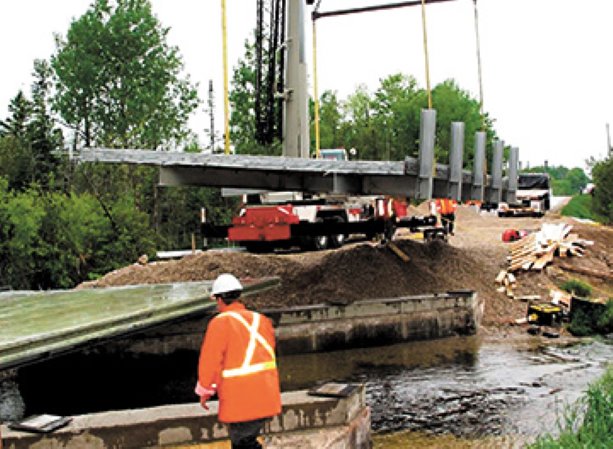One of three spans of Ottawa’s 110-year-old Minto Bridges crossing the Rideau River is being rehabilitated thanks to the use of modern technology. The steel decking is being replaced with a composite material made of a wood core wrapped in fibreglass. The project represents the first time the composite deck material will be used in Ottawa.
The work is being undertaken by Guardian Bridge Rapid Construction of Stratford, Ont. which manufactures and installs the product. The project targets the 53-metre-long span joining Green Island and King Edward Avenue and is being undertaken by engineering consultant Delcan Corporation in partnership with heritage consultant Barry Padolsky Associates Inc., architects for the City of Ottawa. The contract is valued at $2.5-million with the panels representing a cost of about $550,000.
“Load limits on the original steel grating system prevented fire trucks from reaching the [John G. Diefenbaker] building at the Department of Foreign Affairs on the other side of the bridge,” says Crawford Dewar, manager of engineering with Guardian. “The panels are stronger than steel or concrete and weigh about 60 per cent less, allowing for a much larger live load.”
While the steel grating remains in relatively good shape, road salt passing through the grate was corroding structural steel underneath.
The fibreglass wood composite panels, which have a service life of at least 75 years, are a closed system that will deflect road salt away from the support structure underneath the bridge.
The panels were delivered to the site in December. A Guardian crew will take four days to bolt the deck panels to the bridge’s floor beams, probably in early February.
The panels will be edged in white to match the painted surface of the bridge. “We can make it look like oak, stone, marble or any other surface,” says Dewar.
“We could silk screen Disney World characters onto the panels if that’s what the client wants. Once installed, the panels can be paved with asphalt.”
Guardian began research and development on the panels in 1996 when the Canadian Highway Bridge Design Code did not allow the use of fibreglass materials.
“We wanted to start with a material that was already approved in the code,” says Dewar. “We could have used a concrete or steel core, but we decided that wood was the best choice to build on.”
The wood core of the panels is made of finger-jointed black spruce with all knots removed. Each board is tested at 2.4 million psi before being encapsulated in aerospace-grade epoxy.
“Wood absorbs considerable load because of its honeycombed structure,” says Dewar. “However, wood is stronger in the direction of the fibres and weaker in the radial direction. We orient the fibres in the fibreglass to compensate for the radial strength of the wood.”
The panels were first offered commercially in 2000 after Section 16 of the code recognized the patented fibreglass composite. Since then, the company has replaced in excess of 200 bridge decks in Canada and the U.S.
The components are manufactured at Guardian’s plant in large dimensions.
“We specialize in what we like to call big, dumb parts,” says Dewar.
“The biggest part we’ve ever built was an entire bridge 90 metres long for the province of Nova Scotia. It was an eight-inch composite deck already attached to steel beams when it was delivered.”
Guardian recently worked with PCL Constructors Canada Inc. and Mark Eby, construction manager with Wellington County, on the Wellington County Townline Bridge.
“It’s the first time in Canada that a bridge was built using fibreglass wood composite abutments,” says Dewar. “We delivered the 40-foot-long bridge in four large sections.”
Dewar notes that municipalities are eager to specify bridges made with wood core composites, not only because of cost savings, but also because it helps them to fulfill funding requirements that specify sustainable, Canadian-made products.
“The construction industry has shown an increased interest in wood through innovative applications and products,” notes Etienne Lalonde, vice-president of market development with the Canadian Wood Council.
“Wood’s environmental merits, ease of installation, light-weight qualities and structural capabilities make it a viable option for bridge construction.”



Recent Comments
comments for this post are closed